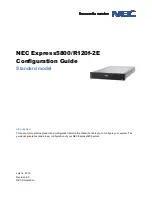
52
storage capacity is equal to the sum of the capacity of all member hard drives.
RAID 0 Striping Disk Volume
: RAID 0 (striping disk) combines 2 or more hard
drives into one larger volume. The data is written to the hard drive without any
parity information and no redundancy is offered. The total storage capacity of a
RAID 0 disk volume is equal to the sum of the capacity of all member hard drives.
RAID 1 Mirroring Disk Volume
: RAID 1 duplicates the data between two hard
drives to provide disk mirroring. To create a RAID 1 array, a minimum of 2 hard
drives are required. The storage capacity of a RAID 1 disk volume is equal to the
size of the smallest hard drive.
RAID 5 Disk Volume
: The data is striped across all the hard drives in a RAID 5
array. The parity information is distributed and stored across each hard drive. If a
member hard drive fails, the array enters degraded mode. After installing a new hard
drive to replace the failed one, the data can be rebuilt from other member drives
that contain the parity information. To create a RAID 5 disk volume, a minimum of 3
hard drives are required. The storage capacity of a RAID 5 array is equal to (N-1) *
(size of smallest hard drive.) N is the number of hard drives in the array.
RAID 6 Disk Volume
: The data is striped across all of the hard drives in a RAID 6
array. RAID 6 differs from RAID 5 that a second set of parity information is stored
across the member drives in the array. It tolerates the failure of two hard drives. To
create a RAID 6 disk volume, a minimum of 4 hard drives are required. The storage
capacity of a RAID 6 array is equal to (N-2) * (size of smallest hard drive.) N is the
number of hard drives in the array.
RAID 10 Disk Volume
: RAID 10 combines four or more disks in a way that protects
data against loss of non-adjacent disks. It provides security by mirroring all data on
a secondary set of disks while using striping across each set of disks to speed up
data transfers. RAID 10 requires an even number of hard drives (a minimum of 4.)
The storage capacity of a RAID 10 disk volume is equal to (size of the smallest
capacity disk in the array) * N/2. N is the number of hard drives in the volume.
Dis k C onfigura tion a nd NAS M ode ls
For disk configuration and applied NAS models, please refer to the table below:
Disk Configuration
Applied NAS Models
Single disk volume
All models
RAID 1, JBOD (just a bunch of disks)
2-drive models or above
RAID 5, RAID 6, RAID 5+hot spare
4-drive models or above
















































